The AMS has introduced a new award in recognition of the career-long dedication and commitment to the advancement of women in the atmospheric sciences by legendary pioneering meteorologist Joanne Simpson.
The new Joanne Simpson Mentorship Award recognizes individuals in academia, government, or the private sector, who, over a substantial period of time, have provided outstanding and inspiring mentorship of professional colleagues or students. The award is separate from the honor bestowed upon exceptional teachers mentoring students, which is covered by the AMS Teaching Excellence Award.
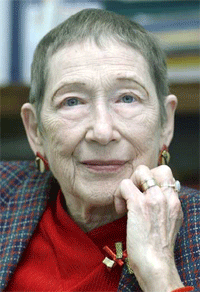
Simpson was the first women to earn a Ph.D. in meteorology, and her distinguished achievements include creating nearly singlehandedly the discipline of cloud studies, determining the source of heat energy that drives hurricanes, and leading a decade-long effort at NASA that culminated in establishment of the ground-breaking Tropical Rainfall Measuring Mission (TRMM). Her career spanned more than 50 years, during which she challenged the male-dominated establishment in meteorology and fought for equal footing for women in the sciences. Although she passed away nearly a year ago, her enduring spirit continues to pave a pathway forward for other women pioneers in meteorology and the related sciences.
As with all AMS awards, nominations for the Joanne Simpson Mentorship Award are considered by the AMS Awards Oversight Committee.
Online submission of nominations for the new award will be accepted until May 1. The first Joanne Simpson Mentorship Award will be presented at the 2012 Annual Meeting in New Orleans.
News
The Weather Museum Names Its 2010 Heroes
The Weather Hero Award is given to individuals or groups who have demonstrated heroic qualities in science or math education, volunteer efforts in the meteorological community, or assistance to others during a weather crisis. The 2010 Weather Heroes honored were the American Meteorological Society, KHOU-TV in Houston, and Kenneth Graham, meteorologist-in-charge of the NWS New Orleans/Baton Rouge office.
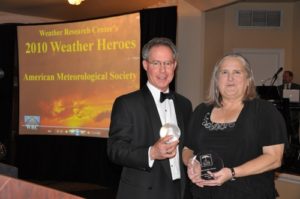
The AMS was recognized for developing and hosting WeatherFest for the past ten years. WeatherFest is the interactive science and weather fair at the Annual Meeting each year. It is designed to instill a love of math and science in children of all ages, encouraging careers in these and other science and engineering fields. AMS Executive Director Keith Seitter accepted the award on behalf of the Society. “While we are thrilled to display this award at AMS Headquarters,” he comments, “the real recipients are the hundreds of volunteers who have given so generously of their time and have made WeatherFest such a success over the past decade.”
KHOU-TV was honored for hosting Weather Day at the Houston Astros baseball field in fall of 2010. Weather Day was a unique educational field trip and learning opportunity that featured an interactive program about severe weather specific to the region. Over the course of the day, participants learned about hurricanes, thunderstorms, flooding, and weather safety—highlighted by video, experiments, trivia, and more.
Graham received the award for his support of the Deepwater Horizon Oil Spill cleanup. As meteorologist-in-charge of the New Orleans/Baton Rouge forecast office in Slidell, Louisiana, Graham started providing weather forecasts related to the disaster immediately following the nighttime explosion. NWS forecasters played a major role protecting the safety of everyone working to mitigate and clean up the oil spill in the Gulf of Mexico.
The awards were presented at the center’s third Annual Groundhog Day Gala and its fifth annual Weather Hero Awards on 2 February 2011.
The Weather Research Center opened The John C. Freeman Weather Museum in 2006. As well as housing nine permanent exhibits, the museum also offers many exciting programs including weather camps, boy/girl scout badge classes, teacher workshops, birthday parties and weather labs.
Commutageddon, Again and Again
Time and again this winter, blizzards and other snow and ice storms have trapped motorists on city streets and state highways, touching off firestorms of griping and finger pointing at local officials. Most recently, hundreds of motorists became stranded on Chicago’s Lake Shore Drive as 70 mph gusts buried vehicles during Monday’s mammoth Midwest snowstorm. Last week, commuters in the nation’s capital became victims of icy gridlock as an epic thump of snow landed on the Mid Atlantic states. And two weeks before, residents and travelers in northern Georgia abandoned their snowbound vehicles on the interstate loops around Atlanta, securing their shutdown for days until the snow and ice melted.
Before each of these crippling events, and historically many others, meteorologists, local and state law enforcement, the media, and city and state officials routinely cautioned and then warned drivers, even pleading with them, to avoid travel. Yet people continue to miss, misunderstand, or simply ignore the message for potentially dangerous winter storms to stay off the roads.
Obviously such messages can be more effective. While one might envision an intelligent transportation system warning drivers in real time when weather might create unbearable traffic conditions, such services are in their infancy, despite the proliferation of mobile GPS devices that include traffic updates. Not surprisingly, the 2011 AMS Annual Meeting in January on “Communicating Weather and Climate” offered a lot of findings about generating effective warnings. One presentation in particular—”The essentials of a weather warning message: what, where, when, and intensity”—focused directly on the issues raised by the recent snow snafu’s. In it, author Joel Curtis of the NWS in Juneau, Alaska, explains that in addition to the basic what, where, and when information, a warning must convey intensity to guide the level of response from the receiver.
Key to learning how to create and disseminate clear and concise warnings is understanding why useful information sometimes seems to fall on deaf ears. Studies such as the Hayden and Morss presentation “Storm surge and “certain death”: Interviews with Texas coastal residents following Hurricane Ike” and Renee Lertzman’s “Uncertain futures, anxious futures: psychological dimensions of how we talk about the weather” are moving the science of meteorological communication forward by figuring out how and why people are using the information they receive.
Post-event evaluation remains critical to improving not only dissemination but also the effectiveness of warnings and statements. In a blog post last week following D.C.’s drubbing of snow, Jason Samenow of the Washington Post’s Capital Weather Gang (CWG) wondered whether his team of forecasters, and its round-the-clock trumpeting of the epic event, along with the bevy of weather voices across the capital region could have done more to better warn people of the quick-hitting nightmare snowstorm now known as “Commutageddon.” He concluded that, other than smoothing over the sometimes uneven voice of local media even when there’s a clear signal for a disruptive storm, there needs to be a wider effort to get the word out about potential “weather emergencies, or emergencies of any type.” He sees technology advances that promote such social networking sites as Twitter and Facebook as new ways to “blast the message.”
Even with rapidly expanding technology, however, it’s important to recognize that simply offering information comes with the huge responsibility of making sure it’s available when the demand is greatest. As CWG reported recently in its blog post “Weather Service website falters at critical time,” the NWS learned the hard way this week the pitfalls of offering too much information. As the Midwest snowstorm was ramping up, the “unprecedented demand” of 15-20 million hits an hour on NWS websites led to pages loading sluggishly or not at all. According to NWS spokesman Curtis Carey: “The traffic was beyond the capacity we have in place. [It even] exceeded the week of Snowmageddon,” when there were two billion page views on a network that typically sees just 70 million page views a day.
So virtual gridlock now accompanies road gridlock? The communications challenges of a deep snow continue to accumulate…
Science Meets Art on Floor 2
Art is a method of communication, a dialogue between artist and audience. The exhibit “Forecast: Communicating Weather and Climate,” currently on display on the second floor of the convention center, is also about communication between artists and scientists. The collaborative exhibit paired up Washington State artists with forecasters, climatologists, and atmospheric scientists with the idea that looking at weather and climate through a different lens opens up a new viewpoint and ultimately greater understanding. The end result is not only interesting artwork but what turned out to be enlightening experiences for those involved. Here’s one of the two interviews with the artists and scientists up on Ametsoc YouTube:
If you haven’t already, stop by to view the photography, paintings, and sculptures that portray the weather in a way you may not have seen before.
For more from the scientists’ perspective, take a look at University of Washington science writer Vince Stricherz’s article.
Congratulations, Student Sleuths!
 The student conference contest had a happy ending, it just ended a little sooner than mere mortals would expect. Torey Farney, of Cornell University won First Prize before 4 pm Saturday by managing to anticipate the answer before the announcement of the last clue…something to do with mathematically narrowing the range of possible answers and inspired guesswork. Or was that ESP (Earth Science Perspicacity)? His prize was a free travel and registration for next year’s Annual Meeting in New Orleans.
The student conference contest had a happy ending, it just ended a little sooner than mere mortals would expect. Torey Farney, of Cornell University won First Prize before 4 pm Saturday by managing to anticipate the answer before the announcement of the last clue…something to do with mathematically narrowing the range of possible answers and inspired guesswork. Or was that ESP (Earth Science Perspicacity)? His prize was a free travel and registration for next year’s Annual Meeting in New Orleans.
Camaron Plourde, of Embry-Riddle University, also answered early, winning Second Prize (an Amazon Kindle); and Leah Werner, of Embry-Riddle, won Third Prize (an Amazon gift certificate).
Not that they were the only ones to answer correctly. Some 80 percent of the attendees solved the quest.
Meanwhile, in a related drawing, Gavin Chensue, Univ. of Michigan won a copy of the AMS book, Eloquent Science, by David Schultz; and Adam Atia, City College of New York, won a copy the recently published AMS book, History of Broadcast Meteorology, by Robert Henson.
Thanks to AMS’s co-sponsors in the Weather Quest, Atmospheric Science Librarians International and the University of Wisconsin-Madison, for the great prizes.
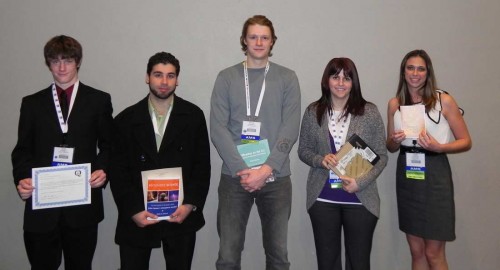
Not Sure What to Say? Talk about Uncertainty.
Since communication is the topic of the week, the new AMS draft statement on “Communicating Science” is never far from our minds during this meeting. The statement is available for comment until 2 February, which means discussions here could help shape that document.
Not surprisingly the statement addresses how AMS membership should communicate not only the “nature and practice of science” but also its results to a wide variety of nonscientific audiences.
One of the most challenging aspects of that communication is summed up baldly in the statement:
Uncertainty is not equivalent to not knowing.
Therein lies a major communication challenge, because the public expect scientists to “know” things by making confident predictions, like where the planet moves and which way things fall.
Yet uncertainty is built into the scientific process just as much as making successful predictions. Uncertainty fuels new experiments and hypotheses. It can be expressed mathematically. And it actually is increasingly a basis for sophisticated, probabilistic decision making tools. Says the draft statement:
In … studies of complex phenomena such as weather and climate, [uncertainty] may contribute to knowing more.
But:
This idea has not been adequately communicated to the public.
Worse yet, as practitioners of prediction, scientists look bad when they admit uncertainty:
In a world of sound bites and rapid-fire news coverage, scientists struggle with how to convey to the public the additional information contained in statements of uncertainty and probability without seeming less credible than other voices conveying the appearance of certainty.
Since uncertainty is at the soul of the scientific process as well as its products, communicating uncertainty is at the very heart of this week’s meetings. A Town Hall meeting on “The Role of the Forecaster in Probabilistic Decision Making” on Monday (24 January, 12:15 p.m., WSCC 606) continues the community follow-up to the 2006 National Research Council report, “Completing the Forecast: Characterizing and Communicating Uncertainty.” In this case, forecasters face a double-whammy. Not only is uncertainty difficult and unwelcome, but, according to the AMS statement draft,
there exists in the public mindset distrust in the ability of models to provide useful information.
On Thursday (27 January, 11 a.m.-12:15 a.m., WSCC 611) we’ll get some concrete examples of overcoming these problems in a session on “Communicating Uncertainty,” part of the Second Conference on Weather, Climate, and the New Energy Economy.” Jeanne Schneider of USDA will open with “The Necessity of Communicating Uncertainty—Lessons from the Interface.” And Deborah Smith et al. of Remote Sensing Systems will talk about “Communicating Satellite MW Ocean Product Errors to a Variety of Users” at noon.
Of course many other presentations will touch on this topic one way or another. One thing is sure: uncertainty is a major part of this year’s discussions.
The Most Difficult "Way of Knowing": Listening
by Raj Pandya, Annual Meeting Co-Chair
The theme of this year’s annual meeting is communication, and I think one of the hardest parts of communication is listening. I find it embarrassingly easy to slip into broadcast mode, and imagine that simply because I want to say it, others will be interested. My 8-year old daughter can be brutal about this: “Daddy, this is boring, can we talk about horses, please.” (I will say, though, I can sneak in a little thunderstorm talk if we frame it around storms’ impact on horse happiness).
So, I am especially looking forward to this annual meeting as a chance to listen, especially to communities we haven’t interacted with before or in places we haven’t gone. There are lots of opportunities in this meeting. The presidential forum opens the meeting with some suggestions about how to address what audiences may be interested in and how to present information in a way that connects. There is a themed joint session on Thursday called “Ways of Knowing” that will explore things from an indigenous perspective. Sunday night, before the meeting kicks off, students will be presenting their research – a great chance to listen to the next generation. On Tuesday, a panel will tackle the challenge of communicating – and listening –across our various disciplines and another set of talks will focus on communication and diversity. Finally, there are sessions that explore communication from a user perspective – including public health, energy, and people interested in tropical cyclones.
The second hardest part about communicating is adapting. I find myself clinging to my preferred mode of communication, even when the audience and circumstance change. It doesn’t always work – in the words of Hawkeye Pierce, “He doesn’t understand loud English, either, Frank”. Even only in English, there are new social media and devices that are rapidly changing the way we communicate.
There are a number of talks at the Annual that tackle this. There are sessions on mobile devices and e-books and a more general session to explore technology that enables communication. There are special sessions demonstrating technology in education and a special session on Thursday looks at how data publishing may change the way we communicate science.
Yogi Berra is reported to have said a whole lot of things, including “You can observe a lot just by watching.” In the spirit of this year’s Annual Meeting, with the theme of communication, I’d suggest, instead: “You can hear a lot by just listening.”
Have fun.
Nowhere to Hide from Snow . . . Except Florida
It snowed throughout the Northeast on Wednesday, but very few are feeling sorry for everyone in that region who had to pull out their shovels. The odds are good that you or someone you know in your state has had to deal with snow lately, too–no matter where you live in the country. According to the NWS’s National Operational Hydrologic Remote Sensing Center, which collects snow cover and depth data from ground reports and satellite observations, 49 of the 50 states currently have some snow cover…even Hawaii (this video was taken last month)! Only Florida has avoided a recent visit from Jack Frost.
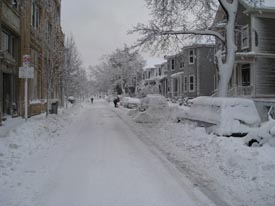
This isn’t an unprecedented event–in fact, all 50 states had snow on the ground last February 12th, and University of Oklahoma meteorology student and AMS student member Patrick Marsh obtained pictures from every state of that day’s snow.
But “it’s not typical,” says James Peronto, public affairs officer for the NWS, who noted that recent snowfall throughout the Southeast has created the unusually white map.
“The Southern states don’t typically get significant snow amounts through the year,” Peronto said. “It takes a special kind of weather scenario to allow that to happen.”
(This quick history lesson on Southern snow illustrates how rarely such a scenario occurs.)
NWS observations show that 70.9% of the country was covered by snow as of yesterday, compared to an average of 35% snow cover in December.

Snow cover and depth analyses like these are not just for interstate precipitation bragging rights or cabin-fever consolation. At the AMS Annual Meeting in Seattle, a number of science presentations will show the value of snow cover observations.
For example, Patricia de Rosnay et al. will present recent “major changes implemented” in the operational surface analysis of the European Center for Medium-range Weather Forecasting’s Integrated Forecasting System,” including a method of combining satellite observations of snow cover for the land surface conditions for weather modeling. (Tuesday, 25 January, 1:45 p.m.; WSCC 611).
Sujay Kumar et al. (poster 42, 9:45 a.m.-11:15 a.m., Tuesday, 25 January), will discuss snow cover from active microwave remote sensing and look at the value of assimilating snow observations from multiple satellites for hydrological modeling. They point out that “Snow conditions on the land surface are … key components of the global hydrological cycle as they play a critical role in the determination of local and regional climate.”
One way in which this is true is in regions where melted snow dominates water supply. On Thursday 27 January (4:15 p.m., WSCC 611) Randal Koster et al. will “examine how knowledge of mid-winter snow accumulation and soil moisture contributes to our ability to predict streamflow months in advance.” In an experiment with multiple land surface models, “snowpack information by itself contributes, as expected, to skill attained in streamflow prediction, particularly in the mountainous west.” (They go on to show the additional importance of soil moisture conditions to long-lead forecasts, particularly in winter.)
Meanwhile, as a basis for the observations used in such studies, Ding Liang et al. (Poster 595; 8:30 a.m-4 p.m., Wednesday, 26 January) will delve into improvements for modeling of microwave emissivity of snow—an important step toward constructed improved snow cover data retrieved from satellite remote sensing.
Uccellini Is AMS President-Elect
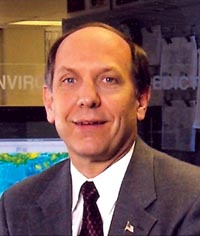
With a huge snowstorm blowing through the northeast United States, it seems an appropriate time to announce that Louis Uccellini has been voted the new AMS president-elect. The director of the National Weather Service’s National Centers for Environmental Prediction, Uccellini has coauthored two acclaimed AMS books on just the kind of snow the Northeast received today: Snowstorms Along the Northeastern Coast of the United States: 1955 to 1985 and Northeast Snowstorms. Uccellini will take over as AMS president in January 2012.
Four new councilors were also chosen in the elections: Peter J. Lamb, Patricia A. Phoebus, William L. Read, and H. Joe Witte. They began their three-year terms in January.
The AMS congratulates all the winners!
Local Storms, International Headaches
With most of us focusing so much on the weather in our hometown, it can be easy to forget that a local weather event can exert global influence. But given recent events in New York City and Panama, it appears that Mother Nature has been trying to reinforce that point.
The post-Christmas snowstorm that hammered much of the eastern United States produced chaos for travelers in a number of states, but it was the 20 inches that fell in New York City that had the farthest reaching impact. The closure of all three NYC metro airports caused a ripple effect that spread across the country and throughout other parts of the world. Not only were throngs of holiday travelers stranded at terminals in New York, but more than 5,000 domestic flights–as well as many in other countries–were canceled and countless more were backed up for days while waiting for LaGuardia, JFK, and Newark airports to get up and running. So, for example, more than 200 flights were canceled at Chicago’s O’Hare and Midway airports solely because of the East Coast snow, disrupting the plans of thousands of travelers even though the blizzard was hundreds of miles to the east.
(Aside 1: What could be a better use of your time when stuck in a snowstorm than this cool time-lapse video shot during the blizzard in the New Jersey shore town of Belmar…)
(Aside 2: There’s that old meteorologists’ adage, “Nobody lives at the Airport”, which happens to be the title of Larry Heitkemper’s presentation at our Seattle meeting, Wednesday 26 January. Heitkemper discusses how to transform official airport observations into data relevant to energy demand where people actually live; apparently, however, when blizzards strike far too many people really do live at the airport.)
Meanwhile, heavy rains last month in Panama forced the Panama Canal to close for just the third time in its 96-year history. Torrential rainfall inundated parts of Central and South America throughout November and early December. Two artificial lakes (Gatun and Alhajuela) in Panama that flow into the canal rose to record-high levels, forcing the canal to close for 17 hours so that one of the lakes could be drained. While the closing was short-lived, the global effects were still significant. About 5% of all international trade utilizes the canal, with approximately 40 ships winding through its 48 miles each day. While sections of the canal have been blocked at times, it was the first time the entire canal was closed since the United States invaded Panama in 1989. The only other closures were caused by landslides in 1915 and 1916, not long after it first opened.